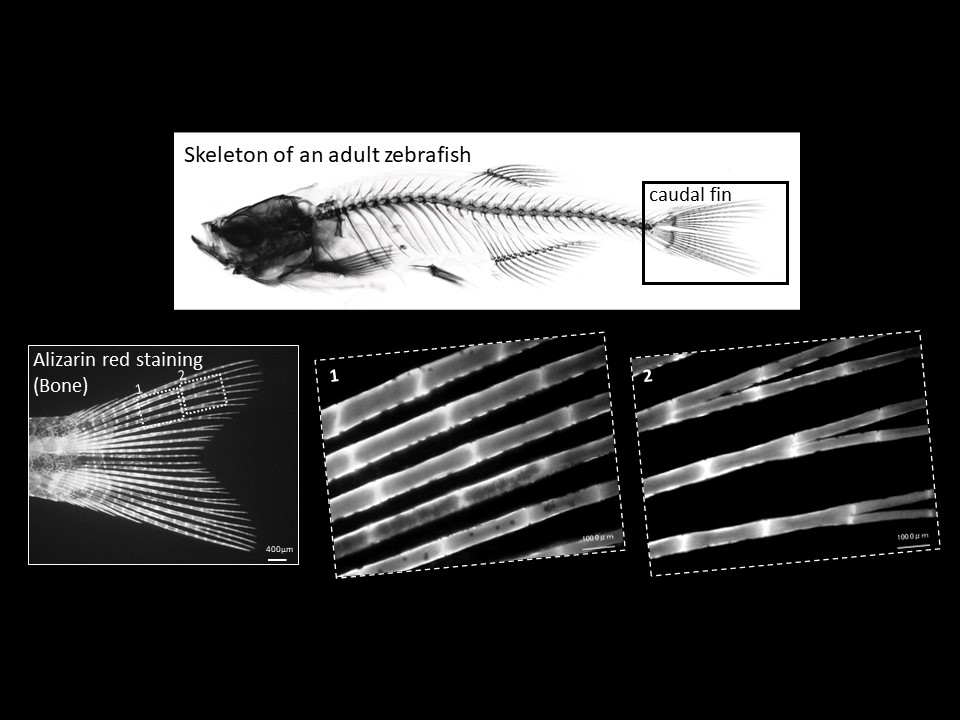FBS Colloquia No.250Laboratory of Pattern Formation
| Seminar or Lecture |
Dynamics of collagen crystals essential for the construction of linear fin bones KURODA Junpei [Special appointment researcher] Spear-shaped collagen crystals as a building material: How are the fin-bones “built” in Zebrafish? NAKAGAWA Hibiki [D4/D5] |
|---|---|
| Date and Time | 1 Oct. 2020 (Thu), 12:15-13:00 |
| Place | Online (Zoom) | An email will be sent with the meeting URL, ID, and password on the morning of each colloquium. |
| Language | English |
| Contact |
Contact:Masakatsu Watanabe |
Title:How to build a body
【Introduction】We aim to elucidate the principle of morphogenesis in late development. When considering late development, there are conditions that are significantly different from early development. That is, the body is "big and heavy" compared to cells. In early development, cells assemble autonomously to form an embryo. That is possible because the embryos aren't big compared to the size of the cell. Since cells are physically fragile, even if they try to form a large adult shape by pumping up the cells, they lack the rigidity to maintain the shape of the body. In many cases, it is bone, cartilage, collagen, etc. that give the adult body rigidity. These themselves are not "cells", but non-cellular structures, and cells produce, transport, and assemble them to form adult shapes.
Dynamics of collagen crystals essential for the construction of linear fin bones
Collagen fiber imparts physical strength and flexibility to tissues such as skin, muscle, and bone by forming huge complexes. For collagen complexes to function properly, the density and orientation of the fibers must be properly determined, but it is not fully understood how this is done. The fins of fish are supported by linearly developing bones, and the tip of each fin bone is connected to thick acicular collagen fibers called actinotricia. It is speculated that actinotrichia must be properly sized and regularly oriented for the normal morphogenesis of the bones. Our research focuses on this unique fin morphogenesis, and we have recently uncovered the mechanism by which cells cleverly utilize actinotrichia as a material to build large bones. In this colloquium, I will report the results of my investigation of the actinotrichia dynamics, 'making', 'arranging', 'transporting' and 'degrading', which is essential for the formation of the fin bone, and introduce a new principle of morphogenesis.
Spear-shaped collagen crystals as a building material: How are the fin-bones “built” in Zebrafish?
Fins of teleost are supported by a dozen fin-bones. However, the fin-bones are only present just before the fin tip, and beyond that point, there are orderly-aligned collagen crystals called actinotrichia. When fin-bones are formed, actinotrichia are bundled parallel and then bone components are deposited there. What do the orderly-aligned actinotrichia play roles in shaping the fin-bone? To answer this question, I generated a mutant with disorganized alignment of actinotrichia, and observed that the caudal fin of the mutant fish shrank dorsoventrally and lost the bifurcation of the fin-bone. By the detailed anatomical analysis, I found that the orderly alignment of the “rigid” actinotrichia at the fin tip—where it is still “squishy” area because the fin-bones are not formed yet—contribute to generate physical tension for the fin to spread out in the dorsal-ventral axis. In this colloquium, I am talking about a mechanical role of actinotrichia for fin-bone formation based on the results obtained.


